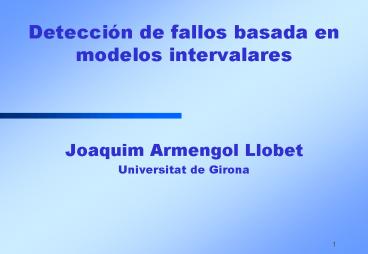Deteccin de fallos basada en modelos intervalares - PowerPoint PPT Presentation
1 / 32
Title:
Deteccin de fallos basada en modelos intervalares
Description:
Branch-and-Bound algorithm based on Modal Interval Analysis. ... SqualTrack is one of the components of MISO (Modal Interval Solver): FSTAR Solver. ... – PowerPoint PPT presentation
Number of Views:52
Avg rating:3.0/5.0
Title: Deteccin de fallos basada en modelos intervalares
1
Detección de fallos basada en modelos
intervalares
- Joaquim Armengol Llobet
- Universitat de Girona
2
Fault concepts
- Fault deviation from the normal, acceptable,
usual, standard behaviour. Abnormal operation of
system, sensors or actuators. - Causes design errors, implementation errors,
human errors, use, wear, deterioration, damages,
ageing - Consequences worse performances, energy waste,
waste of raw materials, economic losses, lower
quality, lower production, environmental damages,
human damages
3
Example
- Internal faults
- Process Tank leakage, clogged pipe.
- Sensor Offset.
- Actuator Valve is blocked.
Controller
4
Fault types
- Depending on the temporal aspects
- Abrupt fault sudden and considerable. Model
step. Example offset. - Incipient or evolutive fault affects slowly.
Model ramp, exponential, parabola. Example
drift (deriva). - Intermitent fault. Model pulses.
5
Tasks
- Fault detection. Determination of the existence
of the fault. - Fault diagnosis. Diagnostic set of components
that explain the fault. - Fault isolation kind, location, root cause,
faulty component. - Fault identification size, type, time of the
fault. - Fault tolerance. Fault handling.
6
Fault detection by analytical redundancy
- The behaviour of the real process and the
behaviour of a model of the process are compared. - Sufficient condition
- IF real_output ? simulated_output THEN fault_alarm
System
Input
Output
Alarm
Comparison
Model
7
Analytical Redundancy
- Problem Behaviours are always different due to
the uncertainty. Uncertainty in industrial
processes makes difficult the fault detection
task.
8
Residuals
- Sufficient condition
- IF real_output - simulated_output gt e THEN
fault_alarm
Input
Output
System
Alarm
Comparison
Model
9
Threshold
- Fixed.
- Variable
- Adaptive.
10
Models expressing uncertainty
- Decreasing precision to increase accuracy.
- Imprecise models
- Qualitative models. Non-numerical values
- Signs positive, negative, increases, decreases
- Orders of magnitude big, small
- Example economy models
- If interest rates grow, unemployment increases.
- Semiqualitative models
- Fuzzy sets.
- Intervals.
11
Uncertainty in models
Example
12
Intervals decreasing precision to increase
accuracy
- Its 11.56
13
Simulation
14
Simulation of uncertain models
- Example 2 tanks.
15
Fault detection by analytical redundancy
- Sufficient condition
- IF real_output ? simulated_output THEN fault_alarm
Output
Input
System
Interval
Envelope
Alarm
Comparison
Model
16
Quantitative simulation Quantitative models
method
- Example
- Systematically Randomly
17
Quantitative simulation Quantitative models
method
- Internal envelopes.
18
Quantitative simulationRange computation
- Example difference equation model
- Goal finding for each time point t
- and s.t.
- 2 cases
- Parameters vary in time ? time variant ?
independent functions. - Constant parameters ? time invariant ?
dependent functions.
19
Quantitative simulationRange computation
- Global optimisation algorithms.
- Why global? Local optima ? Internal estimation of
the envelope. - Computational cost is very high.
- Exact can not be obtained at least due to
rounding errors ? Exact envelope is not known. - Error is not known ? Distance to the exact
envelope is not known. - Some of them are based on intervals.
20
Interval Arithmetic
- Moore, 1966.
- Interval
- Interval operations
21
Example of interval computation
- We want to compute the
- value of the function
- for
- The solution is
x
22
Interval Arithmetic
- Natural extension of a real function.
- Property monotonic inclusion.
- Multi-incidences ? outer estimation.
23
Modal Interval Analysis
- Interval
- Modal interval
- interval quantifier
- Canonical notation
24
Modal Interval Analysis
- Modal interval extensions
- Interval Analysis. Unique semantics
- Modal Interval Analysis. Many different
semantics - Examples
25
Modal Interval AnalysisImportant properties
- Interpretable Modal Interval extensions
- ? Semantics of external and internal estimations.
- Coercion theorems allow to obtain better
approximations of f and f efficiently and
taking multi-incidences into account. Example
26
F algorithm
- Branch-and-Bound algorithm based on Modal
Interval Analysis. - Provides inner and outer approximations of the
exact result.
27
Fault detection using error-bounded envelopes
28
Algorithm for FD with error-bounded envelopes
- Use of the output measurement into the iterative
algorithm for generating error-bounded envelopes - Outer zone ? Stop. FAULT.
- Inner zone ? Stop
- Either normal behaviour.
- Or fault can not be detected.
- Shift sliding window.
- Intermediate zone ? Iterate until outer or inner
zone.
29
CHEM TB3.2b SQualTrack
30
SQualTrack Architecture
31
Inner approximation Outer approximation Interval
measurement
Shows a bar when a fault is detected When the
intersection between the interval measurement and
the external band is void
Window length that has been used at each time
step to compute the band
32
SQualTrack v. 2
- SqualTrack is one of the components of MISO
(Modal Interval Solver) - FSTAR Solver.
- QRCS Solver.
- QSI Solver.
- MINIMAX Solver.
- SQualTrack Solver.
- http//pau.herrero.googlepages.com/software































